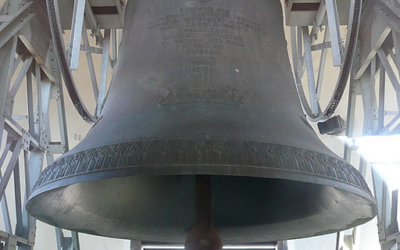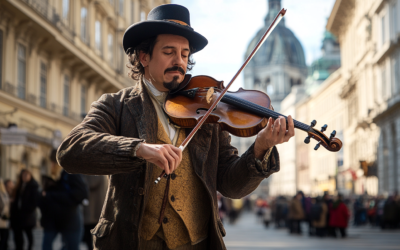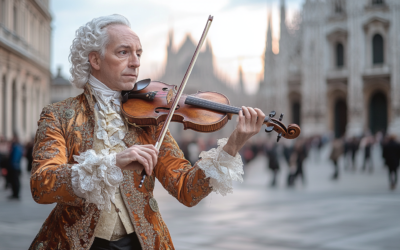Letters Under Surveillance
How Mozart's Family Navigated the Dangerous 18th Century Postal System
In the 18th century, privacy in correspondence was non-existent. Letters were routinely opened and inspected, making it essential for the Mozarts to be cautious with their words. This vigilance is reflected in Leopold Mozart’s carefully crafted letters, which reveal much about the family’s calculated self-presentation
Mozart: The Fall of the Gods
This book offers a fresh and critical look at the life of Wolfgang Amadeus Mozart, challenging the myths that have surrounded him for centuries. We strip away the romanticised image of the “natural genius” and delve into the contradictions within Mozart’s extensive biographies. Backed by nearly 2,000 meticulously sourced citations, this work invites readers to explore a deeper, more complex understanding of Mozart. Perfect for those who wish to question the traditional narrative, this biography is a must-read for serious music lovers and historians.
"Leopold Mozart’s letters were not just personal communications; they were crafted with the knowledge that others—beyond the intended recipient—would likely read them."
Mozart: The Fall of the Gods
In the 18th century, privacy as we understand it did not exist. Letters travelling long distances were often intercepted and inspected before reaching their recipients. By the late 1700s, postal authorities were formally instructed to open and examine correspondence, a task overseen by the Thurn und Taxis family of Regensburg. This family, holding the postal monopoly across much of Europe, made a fortune exploiting the sensitive information gleaned from letters. Count Thaddäus von Thurn und Taxis, in particular, had close ties to the Rothschilds and the Bavarian Illuminati, with Adam Weishaupt encouraging his followers to recruit postal officials to assist in “facilitating correspondence.”
Amid this climate of surveillance, Leopold Mozart’s letters were written with extreme caution, particularly during his travels across Europe. Local political matters were conspicuously absent from his correspondence, which instead focused on more mundane travel details and updates about people in Salzburg. Leopold was careful not to touch on controversial topics, reflecting his prudence—a trait that permeates every aspect of his letters.
“Leopold Mozart’s letters were crafted to carefully construct a narrative of success, avoiding any mention of failure or struggle.”
Interestingly, neither Leopold nor Wolfgang displayed much curiosity about the political landscapes of the countries they visited. The Mozarts’ letters were largely formulaic, recounting only their movements, minor travel mishaps, and the warm receptions they received at various courts. For Leopold, these letters also served a strategic purpose: they were designed to convince the Archbishop of Salzburg—who had funded parts of their travels—of the benefits of his investment. By painting a glowing picture of Wolfgang’s successes, Leopold sought to assure the Archbishop that the family was fulfilling its obligations.
Leopold’s letters, however, reveal a deeper frustration. Despite his efforts to secure prestigious positions for Wolfgang, he doubted that the Archbishop would ever grant his son the recognition he believed he deserved. His correspondence often hints at anxious anticipation, hoping that the constant travel and noble praises would eventually lead to something more permanent.
The Illusion of Universal Praise
Leopold’s letters are filled with flattering depictions of Wolfgang’s receptions across Europe, but these accounts are highly selective. The letters highlight Wolfgang’s interactions with aristocrats and his apparent charm, but they omit less glamorous encounters with ordinary musicians or less significant hosts. When such figures are mentioned, it is often to contrast their insignificance with Wolfgang’s supposed brilliance.
This selective narrative becomes especially clear when Leopold compares Wolfgang’s serenades with other works performed at court. For instance, Leopold claims that Wolfgang’s serenade in Milan overshadowed an opera by Johann Adolf Hasse, but other contemporary accounts, such as those of Giuseppe Parini, tell a different story. Parini’s writings reveal that Hasse’s performance was far from the failure that Leopold suggests, demonstrating how the elder Mozart manipulated facts to maintain the image of Wolfgang as a prodigious talent deserving of admiration and support.
A Carefully Constructed Image
Leopold’s letters were not just family correspondence; they were crafted to be circulated among the elite. Many of the original letters have been lost, and what remains are often copies. This strongly suggests that the letters were intended to be shared widely to bolster the family’s image. Leopold’s letters were part of a larger strategy to present Wolfgang as a rising star, carefully omitting failures or negative experiences.
Leopold also used cryptic language in his letters to avoid the scrutiny of postal censors. Phrases like “for your eyes only” or “not everything can be written” appear frequently, signalling that there were details he chose not to include in writing. Even when recounting their successes, Leopold was mindful of the potential readers beyond the intended recipient.
In a world without privacy, where correspondence was a tool for diplomacy, business, and self-promotion, Leopold Mozart mastered the art of crafting letters that served multiple purposes. His letters reassured patrons, informed friends, and maintained a carefully constructed narrative of success, all while avoiding topics that could harm the family’s reputation. The letters are a testament to the calculated nature of Leopold’s approach to navigating the complex world of European courts.
@mozartrazom
You May Also Like
The Echo of the Pummerin Bell
The powerful resonance of the Pummerin bell in Vienna may have influenced Mozart’s compositions, particularly Sarastro’s arias in The Magic Flute.
The Hidden Influence of Joseph Boulogne, Chevalier de Saint-George
Joseph Boulogne, known as the “Black Mozart”, was shaping the future of music while Mozart was still struggling for recognition in Paris. But history has buried the significant influence Saint-George had on Mozart’s career, erasing his pioneering style from the narrative.
The Forgotten Viennese Quartets
Attributing Offertorium K.34 to Mozart is not just misleading, it reflects the careless methods used by 19th-century scholars to inflate his legacy. Without an autograph or solid evidence, this work should not be considered part of his output.”
Mozart’s Bassoon Concerto: A Question of Authorship
The Bassoon Concerto K.191 raises more questions than it answers. Long thought to have been composed for a Munich bassoonist, new evidence suggests Mozart had no clear performer in mind. The concerto’s disjointed movements and other dubious compositions attributed to Mozart add further complexity to his legacy
The Uncertain Origins of Mozart’s Early String Quartets
Mozart’s so-called “Milanese Quartets” (K.155, 158, and 159) have long been subject to debate, primarily due to their ambiguous instrumentation and structural weaknesses. Were these works part of a larger series of orchestral divertimenti, hastily repurposed as string quartets? The answer remains elusive, reflecting the young composer’s struggles to find his own voice.
Simplicity, Errors, and the Myth of Perfection
Mozart’s canons are not as complex as often claimed, with notable errors in K.553 and K.554, and the myth of “V’amo di cuore teneramente” K.348 being debunked.







